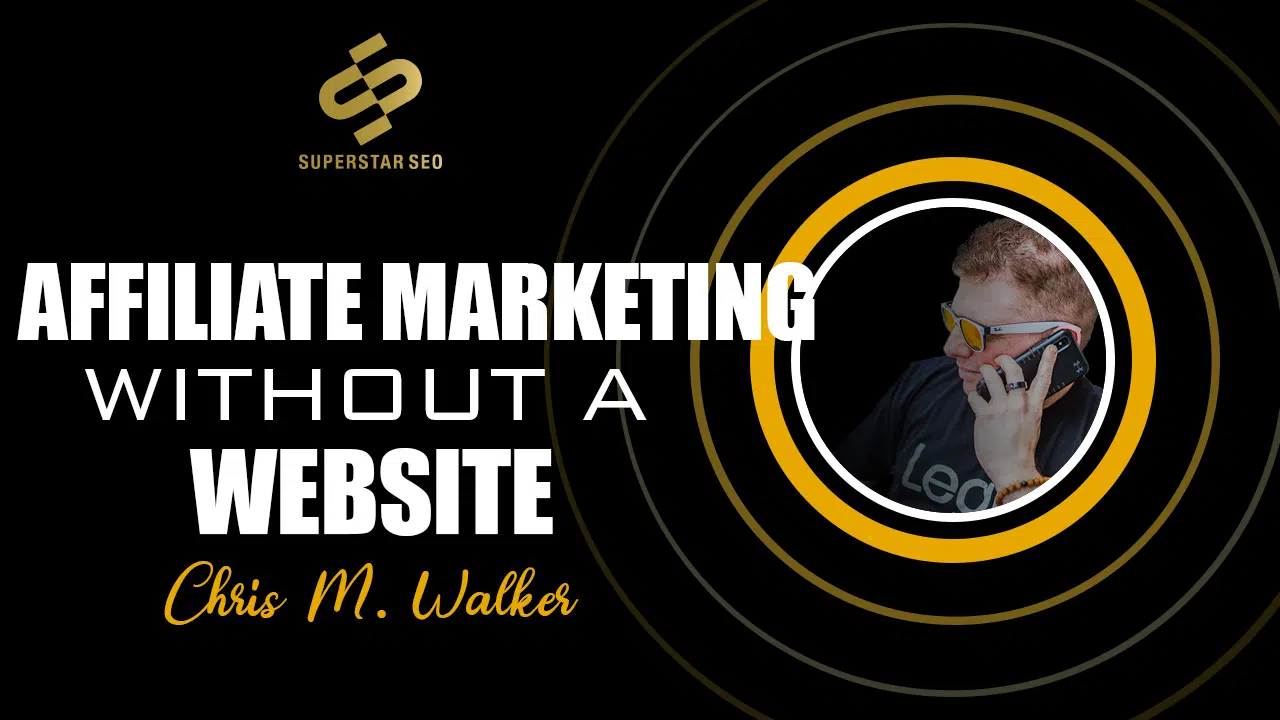How to Start Affiliate Marketing Without a Website (2022)
Building an affiliate marketing website from scratch can be an overwhelming and costly venture.
Plus, it takes time to rank a website on search engines like Google.
This is why many affiliate marketers skip this step.
If you are one of those, you’d be glad to know this:
You can be a successful affiliate marketer without a blog or website.
Affiliate marketing is all about selling others’ products, and there are countless ways to sell something online.
In this post, I’m addressing the question, “How to start affiliate marketing without a website” in detail.
Let’s start.
What Do You Need to Be a Successful Affiliate Marketer?
Before we get into the details of how to start affiliate marketing without a website, it’s important to understand what exactly you need to generate affiliate commissions.
As it turns out, you don’t need a lot to get started and be successful at affiliate marketing.
An Affiliate Offer
Obviously, there’s no way you can become an affiliate marketer without a good affiliate product or offer.
Your first task as an affiliate marketer is to find the right products/offers to promote to an online audience.
It would be awesome if it was something that you are passionate about, but not a necessity.
See, many aspiring affiliates are stuck at this stage just because they believe promoting something they are not passionate about won’t work.
That’s not true.
But, of course, you should feel comfortable or believe in a product you are promoting.
Otherwise, how can you convince your audience to buy it?
Traffic Source(s)
Simply having a great offer won’t be enough. You need to put that offer in front of the right people in the right way.
Finding the right traffic sources is a challenge, though.
While an affiliate website can be one of the most sustainable traffic sources for high-quality traffic, it’s not the only one.
You can use social media, forums, web 2.0 sites, and similar platforms, too.
The key is to create content that aligns with your audience’s needs.
That’s all you need to get started as an affiliate marketer.
Now, let’s move to the tricky part; marketing your affiliate product the right way.
While selling affiliate products online can seem like a pretty simple task, it’s easier said than done.
This is why many affiliates build custom landing pages for their affiliate offers.
Why Do Affiliates Need Landing Pages?

Visit an affiliate website and you’ll probably see dedicated landing pages promoting specific affiliate offers.
Why’s that?
Because custom landing pages are great for conversions!
Let’s see how custom landing pages in affiliate marketing work.
An affiliate landing page is a single web page with nothing but content related to a single affiliate offer.
The goal, of course, is to get the readers to click on your affiliate link and take the required action.
The action could be a sale or a newsletter sign-up, depending on the affiliate program.
Importantly, your landing page’s traffic sources don’t matter as long as they are relevant to the offer.
Generally, people don’t want to click on any link thrown their way.
A landing page gives your offer some credibility. It helps you communicate your message effectively before asking your prospects to purchase your product.
Plus, affiliates use landing pages to qualify their audience.
Because when someone visits your landing page, they are already interested in whatever you have to say.
This filters out the people that aren’t really interested in what you have to say, helping your conversion rate.
Moreover, a dedicated landing page provides all kinds of details about a product, which helps users make an informed decision.
In addition, when you have an optimized affiliate landing page, you can gather information about your traffic.
And, relevant information about your target audience isn’t something a smart affiliate would say no to.
It can help you target and retarget prospects more effectively.
But, it should be clear to you by now that while an affiliate website or landing page can help, it’s not a necessity.
With all that being said, it’s time to have a look at the affiliate marketing strategies that don’t need a website to be effective.
Ways to Market Affiliate Products Without a Website
Now, obviously, the method you choose to promote affiliate products will largely impact your results.
So, it’s important that you have a good understanding of every technique in order to generate maximum results.
Let’s dive in.
Solo Ads
Solo ads can be one of the most cost-effective ways to generate affiliate sales if you don’t have a website.
They allow you to put your affiliate product in front of your target audience by leveraging email lists of other marketers.
What this means is that you can market your products to a highly targeted audience without having to build one yourself.
The strategy saves you the time you’d spend on building your own email list from scratch.
But, of course, you won’t own that list. We’d get to how you can build your own email list without a website in a while.
Let’s try to understand solo ads with a simple example; assume that you want to work in the healthcare niche.
You get yourself registered as an affiliate with relevant companies and are looking for different ways to promote their products.
One of the ways would be to find influencers in the healthcare niche that allow solo ads in their email campaigns.
If your offer is good enough, the influencers would be happy to share your product with their audience.
While the compensation model can vary, they generally charge on a per-click basis.
Using solo ads, you can start selling affiliate products instantly.
But, make sure you work with the right influencer.
Don’t go with the one that has a huge but unrelated audience.
Instead, go with the ones that have a relevant audience. Although the size of the audience does matter, it isn’t the only factor to consider.
Solo ads can be great for affiliate marketing, but keep in mind that they aren’t always cost-effective.
This is because they may not always attract the right kind of traffic to your affiliate offer.
So, it’s a good idea to always have a critical approach and avoid signing a long-term contract with an influencer.
Online Forums and Communities
Thanks to online forums and communities, it’s easier than ever for like-minded people to group together and form communities.
If you have a product that makes sense for a particular group of people, an online community group could be a good place to market it.
The first challenge you’d face with this affiliate strategy is finding the right online communities. Communities that also allow affiliate links.
For instance, on Reddit, you can easily find multiple communities around a specific product category.
Just enter the keyword in the search bar and you’ll be shown a list of relevant communities that you can join and start interacting on.
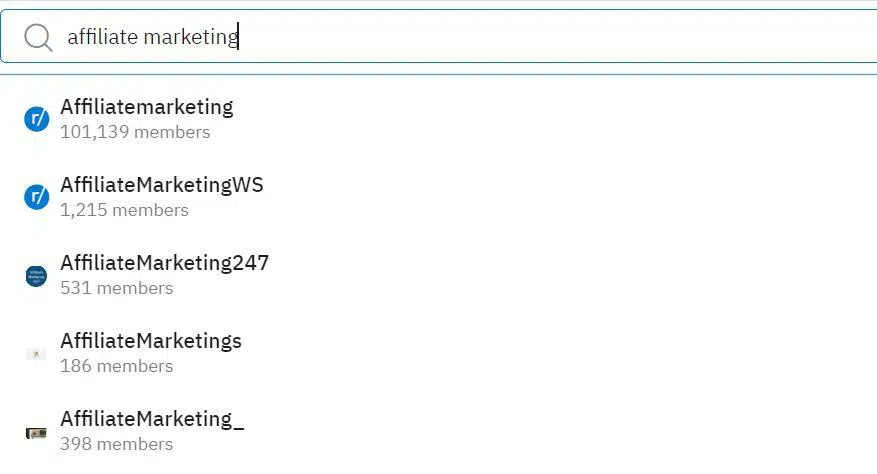
Don’t forget to check the promotional guidelines of a particular subreddit before posting content.
Moreover, you want to add value with your comments and posts before asking people to check your products.
Trying to get people to buy your affiliate product right from the word go can easily put you on the spammers’ list.
And, you want to be an affiliate marketer, not an affiliate spammer.
Therefore, make sure to add value to your content before telling people about your affiliate product.
Try to win their trust; conversions will come automatically.
Create Viral Content
Now, this can be tougher than you might think, but the formula seems simple:
Create something that everybody on the internet would want; it could be an e-book or a video. What really matters is the content.
The secret, of course, would be that your content will have affiliate links in it.
So, whenever someone clicks on any of those links and takes the desired action, you make a pre-determined commission.
But, although that might seem like a great idea, it’s very unlikely that you can tell about a piece of content if it’s going to go viral or not.
If creating viral content was that easy, every affiliate marketer would be successful doing it.
You can invest your resources in creating something in hopes to generate a buzz, but hope doesn’t make a business model sustainable.
Is it possible to make affiliate income through viral content?
Yes!
But, there’s a lot of work involved, and no guarantees.
For instance, you could try to create a viral e-book on a topic that can get people’s attention.
The topic of the e-book could be something related to a trending hashtag. Or, maybe something valuable to your target audience.
Next, you need to smartly embed affiliate links in your content.
If anyone reading your e-book likes the content and clicks on an affiliate link, they might convert.
Pro tip: Use Google Trends to find trending topics and create content accordingly.
YouTube Channel
Now, this is arguably the most popular and effective affiliate marketing strategy after a niche website.
There are more than 2.24 billion active YouTube users around the globe.
What does that tell you? It’s the largest video search engine on the planet.
This is why affiliates have been able to create ridiculously successful affiliate channels on YouTube.
But, what really is YouTube affiliate marketing?
Simply put, it’s when you generate affiliate income by recommending or suggesting affiliate products to your viewers.
The best place to include affiliate links on YouTube is a video’s description. But, there are other places to put your affiliate links on YouTube, including:
- Annotations
- Comments
- Community section
The good thing is: YouTube allows you to place these affiliate links. It just requires that you provide a disclaimer every time you do that.
What Type of Videos to Use for Affiliate Marketing on YouTube?
There’s literally no limit to the type of videos you can use to promote affiliate offers on YouTube.
In fact, you might want to have a versatile approach to video marketing to keep your audience engaged.
That said, affiliates typically find success with a few proven formats.
Product Review Videos: Single product reviews or product comparison videos work great as they help people to make informed purchasing decisions.
The fact that 62% of consumers watch online reviews before making a purchase is clear evidence of that.
How-to Videos: Product review videos aren’t the only way to recommend products.
How-to videos can also be pretty effective at that.
What you can do is create helpful how-to videos and recommend relevant products along the way.
This way, you don’t sound salesy, which typically works in your favor.
Best Of Videos: Best of videos can also be pretty effective, especially when you are a subject matter expert.
And, because these videos talk about multiple products, there is a higher chance of generating conversions.
Examples of best of videos:
- Best hiking boots
- Best golf balls
- Best SEO tools
Getting Traffic to a YouTube Channel
Getting organic traffic to your YouTube videos is actually not that difficult.
YouTube’s own algorithm provides a push to its videos.
But, you can only attract organic traffic when you know what your target market is searching for.
The trick is to find the right keywords, identify their intent, and produce videos around them.
While there are many handy free and paid keyword research tools designed for YouTube, you don’t need to use them.
YouTube autosuggest can be a great way to find the topics that are popular in your industry.
Like Google search bar, the YouTube search bar also suggests a list of phrases when you start typing something.

These autosuggestions are commonly searched terms on YouTube.
What you can do is, insert all related ones in different areas of your YouTube video while editing and uploading it.
And, because YouTube results are also shown on Google, you can also attract organic traffic from the number one search engine.
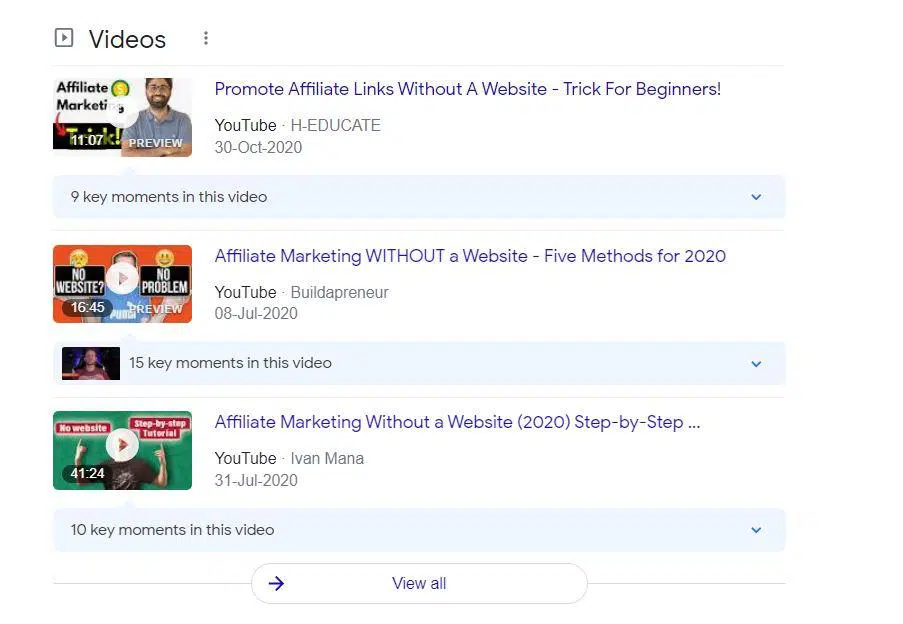
Another good thing about working on YouTube is that the algorithm automatically pushes your videos to the relevant users.
But, of course, a more sustainable way of getting high-quality traffic to your website is by building your own audience.
So, make sure to also focus on building a following on the video hosting platform so that your new videos get immediate traction.
Benefits of YouTube Affiliate Marketing
Let’s quickly walk you through the benefits of affiliate marketing on YouTube.
Massive audience: YouTube is the world’s most popular video search engine with millions of videos on all kinds of topics.
Lower competition: Because creating impactful videos and ranking them require a different skill set, there’s typically less competition on YouTube for most niches.
Minimum investment: You can literally start creating YouTube videos right now and promote all kinds of affiliate offers for free.
Easy SEO Affiliate Marketing: Ranking YouTube videos on Google’s first page is pretty straightforward.
Disadvantages of YouTube Affiliate Marketing
You don’t own it: Probably the biggest disadvantage of doing affiliate marketing on YouTube is that you don’t own the domain.
So, if for some reason, YouTube thinks your account shouldn’t be out there, you can’t really do anything.
Pay-Per-Click Marketing
If you have some budget and want to get quick results, PPC advertising is your best bet.
Done right, advertising provides quick and lucrative returns.
Two of the most popular PPC ad platforms are Facebook ads and Google ads.
The PPC model ensures that you only get charged when a prospect clicks on your ad.
However, you don’t want to work on highly competitive keywords as you’ll have to pay more to get a click.
Content Publishing Platforms
You don’t have to create and grow a website to do affiliate marketing, but that doesn’t mean you can’t use content marketing.
Content publishing platforms like Medium let you publish blog posts for free.
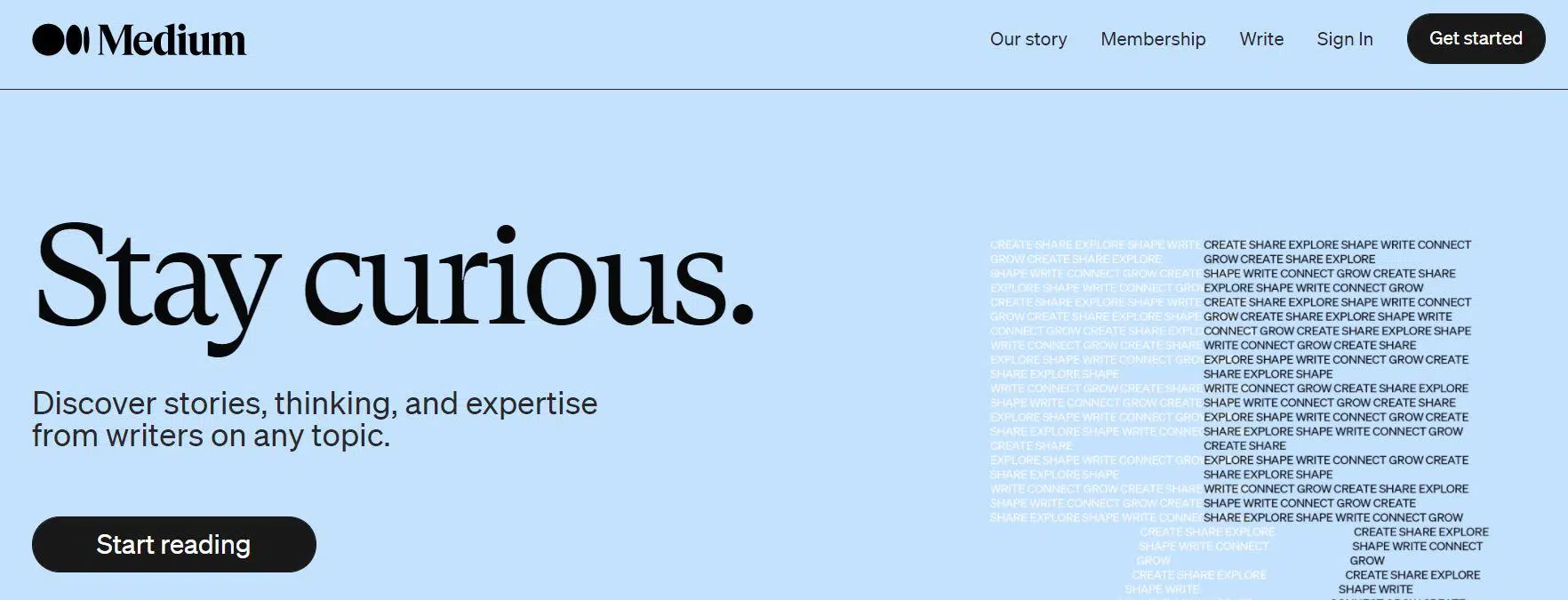
The nice thing is: These domains already have authority with Google, which makes ranking a blog post easier.
Medium also lets you include affiliate links in your content as long as you are providing a disclaimer.
Social Media Platforms
Social media platforms like Facebook, Instagram, and Pinterest can be incredibly effective for affiliate marketing.
While it’s not always ideal to post affiliate links directly on social media, many affiliate networks don’t have a problem with that.
For instance, you can include affiliate links in your Pinterest pins and send the traffic directly to the affiliate product page.
Let’s see how you can leverage Pinterest for affiliate marketing.
Because Pinterest is a visual search engine, you’d need to create eye-catching pins to grab people’s attention.
But, before that, you need to find the keywords that Pinterest users are searching for.
Just like Google and YouTube, Pinterest has its own search algorithm.
Let’s say your blog post is on “How to start affiliate marketing without a website”.
Users on Pinterest would be searching similar terms.
What you can do is, start typing a part of the phrase and notice the suggestions.
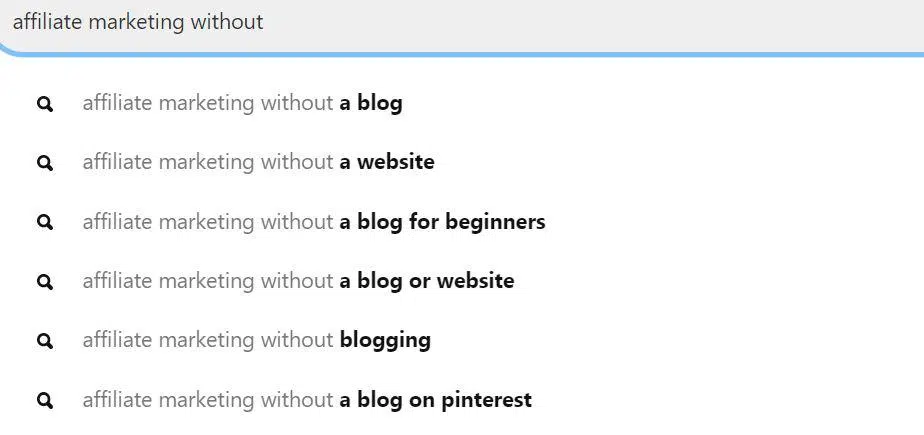
Once you find the right keywords to target on Pinterest, create attention-grabbing pins with free software like Canva.
Don’t forget to include your target keyword in the title and description of your pin.
Email Marketing
Let’s get something out in the open: You don’t have to have a web page or a website in order to capture prospects’ emails.
For instance, you can do that through Facebook lead ads or Google forms.
Facebook lead ads can be pretty effective because they make filling out a form pretty easy for the prospects.
Plus, if you target the right audience, Facebook ads can be pretty inexpensive.
Why would anybody give their email address to you, though?
You offer them something in return; some call it a lead magnet.
It could be anything your prospect would like to get their hands on.
An e-book that addresses their pain points or a guide that tells them how to solve a problem would be a couple of examples.
But, how to promote affiliate products through emails?
Same as you’d promote them through any other channel; first, you add value through helpful content, and then you subtly promote your affiliate products.
Also, make sure that you only invest your resources in the right audience.
Because if someone isn’t interested in your business from the beginning, it’d take a lot of convincing to convert them later.
Keep in mind that some affiliate programs might not allow you to include affiliate links in your emails.
So, you want to read their terms and conditions before getting into the promotion mode.
For instance, the Amazon Associates program doesn’t allow affiliates to include links in emails.
Tips on How to Start Affiliate Marketing Without a Website
While it’s possible to create a sustainable source of income through affiliate marketing without a website, it’s not that easy.
So, here are a couple of useful tips:
Diversify your efforts: When you don’t have an affiliate website, it’s a good idea to diversify your efforts and implement multiple strategies at a time.
For instance, we’ve talked about 8 strategies in this post; try to implement at least 6 of them.
Don’t ignore keyword research: Whether you are trying to attract potential buyers organically or trying to reach them using ads, targeting the right keywords is imperative.
Use Google and YouTube autosuggest to see what your audience is looking for.
Final Thoughts
This was all about how to start affiliate marketing without a website.
To be honest, having an affiliate website where you can test and improve your marketing strategies is always recommended.
But, if you don’t want to go that route, or maybe try other strategies, an affiliate website isn’t a necessity.
Keep in mind that some affiliate programs might require that you own a website with a decent amount of traffic.
But, generally, your only goal in affiliate marketing is to generate sales, and you can do that without a website.



